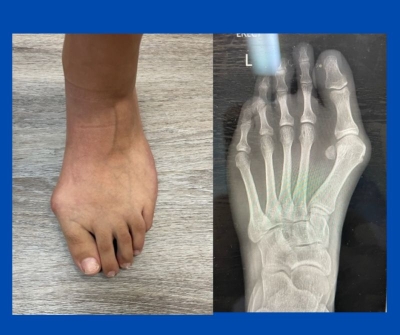This case shows just how strong genetics can play in the development of bunions. This is the foot of a 16-year-old. The parents and podiatrist have been diligent with orthotics and ID wedging from an early age. There is a strong family history of bunions, and the genetic predisposition for the first metatarsal to migrate, I’m afraid, was too strong for any interventions to stop the bunion. It could have slowed its progression and helped with symptoms. However, the deviation is now quite marked, as seen in the imaging below. The patient is currently experiencing deep joint pain, which always concerns me as this can signify that cartilage damage has commenced.
The early intervention with orthotics etc. has not stopped the development of the bunion. However, it may have allowed the child and parents to put the surgery off until they are a bit more mature to undertake the surgery. In these large painful juvenile bunions, I try to wait until they are 16, but sometimes pain and deformity may dictate earlier intervention. I had a child about two years ago who had huge, very painful bunions with the commencement of crossover toes who could not play any sport and was keen to move to surgery ASAP.
The child and parents of the foot below are keen to move to surgery now as the pain is persistent, and the patient is very self-conscious about the foot.
If you have any specific questions or would like to discuss similar cases, feel free to contact me.
Also read:
Gout deposits (not bunions)
The problems with keyhole bunion surgery
Biomechanics of a pathology (bunions and pes planus)
Improvements in bunion surgery
Bunion surgery: Modern procedures for quick recuperation and long-term results
(This content is intended for healthcare professionals only)

